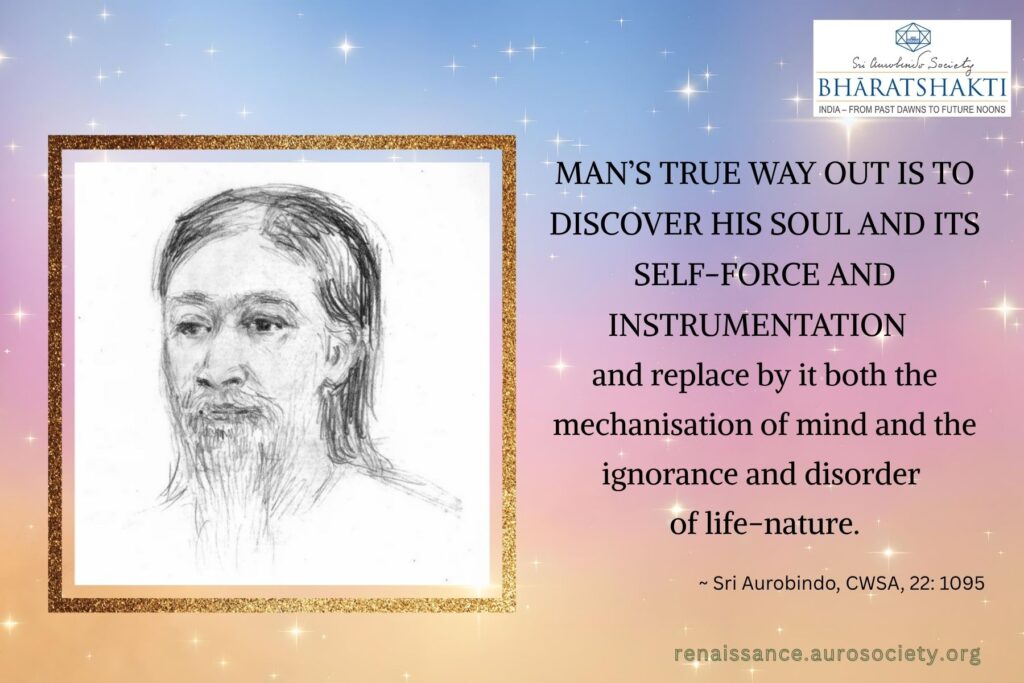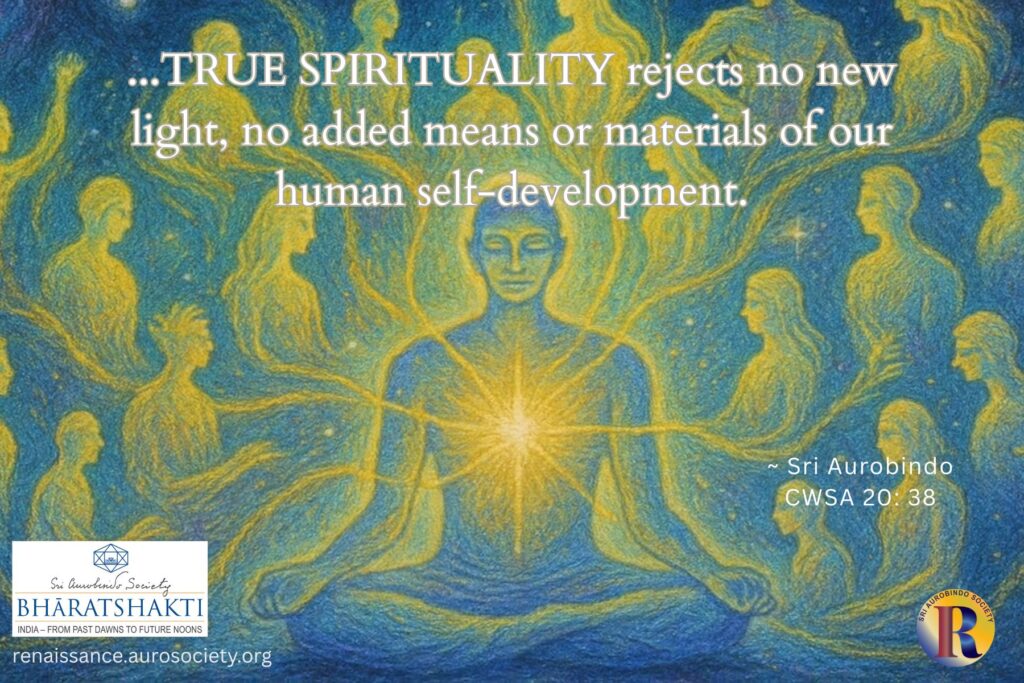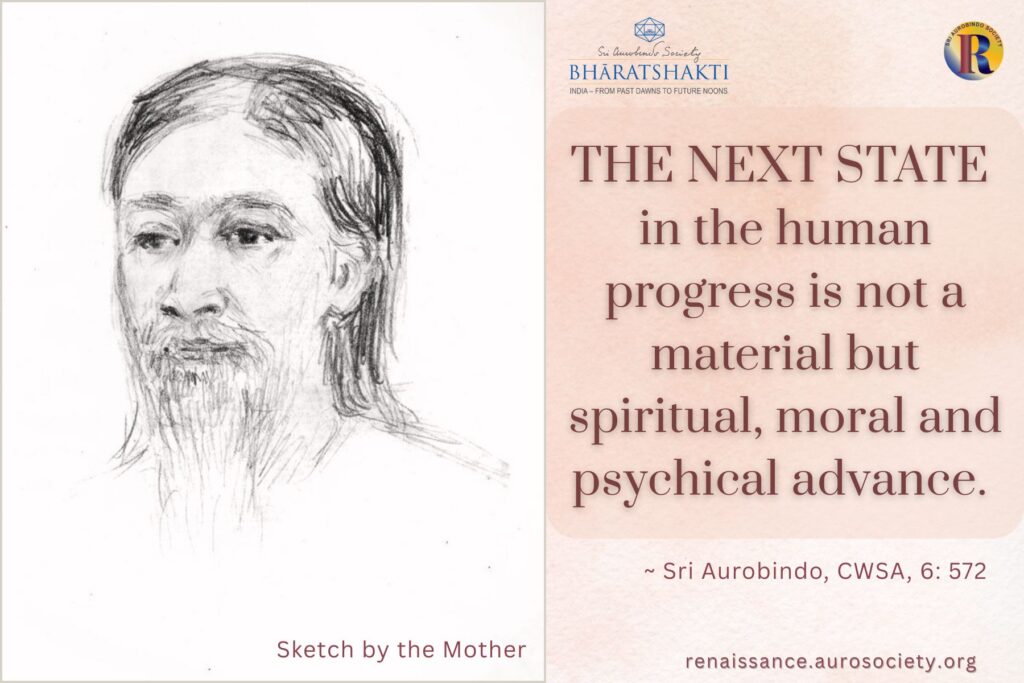Volume V, Issue 9
Author: Beloo Mehra
Shakti, Force, pouring through the universe supports its boundless activities, the frail and tremulous life of the rose no less than the flaming motions of sun and star. To suggest the strength and virile unconquerable force of the divine Nature in man and in the outside world, its energy, its calm, its powerful inspiration, its august enthusiasm, its wideness, greatness, attractiveness, to breathe that into man’s soul and gradually mould the finite into the image of the Infinite is another spiritual utility of Art. This is its loftiest function, its fullest consummation, its most perfect privilege.
Sri Aurobindo, CWSA, Vol. 1, p. 452
“Spiritual utility of Art” — this very phrase brings to mind a clarity that in India, the Art has always been identical in its aim as the rest of the culture. That aim is to facilitate the spiritual growth of the individual and the collective. But before Art can fulfill this role, it must serve several other purposes. And Sri Aurobindo explains that masterfully in his essay titled The National Value of Art.
He says that the first and the lowest use of Art is the purely aesthetic. The second is the intellectual or educative, and the third and highest is the spiritual. By speaking of the aesthetic use as the lowest, he did not imply that this is not valuable. In fact, this aesthetic purpose is of immense importance to human progress. And until this work has been done, humanity is not really ready to make full use of Art on the higher planes of human development.
Listen to our latest podcast
Three Uses of Art
In Sri Aurobindo’s and the Mother’s vision of integral human development, cultivating a sense of beauty occupies an important place. The Mother said that it is one of the greatest weapons of the Asura at work when we are taught to shun beauty. She added that it has been the “ruin of India.”
“The Divine manifests in the psychic as love, in the mind as knowledge, in the vital as power and in the physical as beauty. If you discard beauty it means that you are depriving the Divine of this manifestation in the material and you hand over that part to the Asura.”
~ CWM, Vol. 13, pp. 372-373
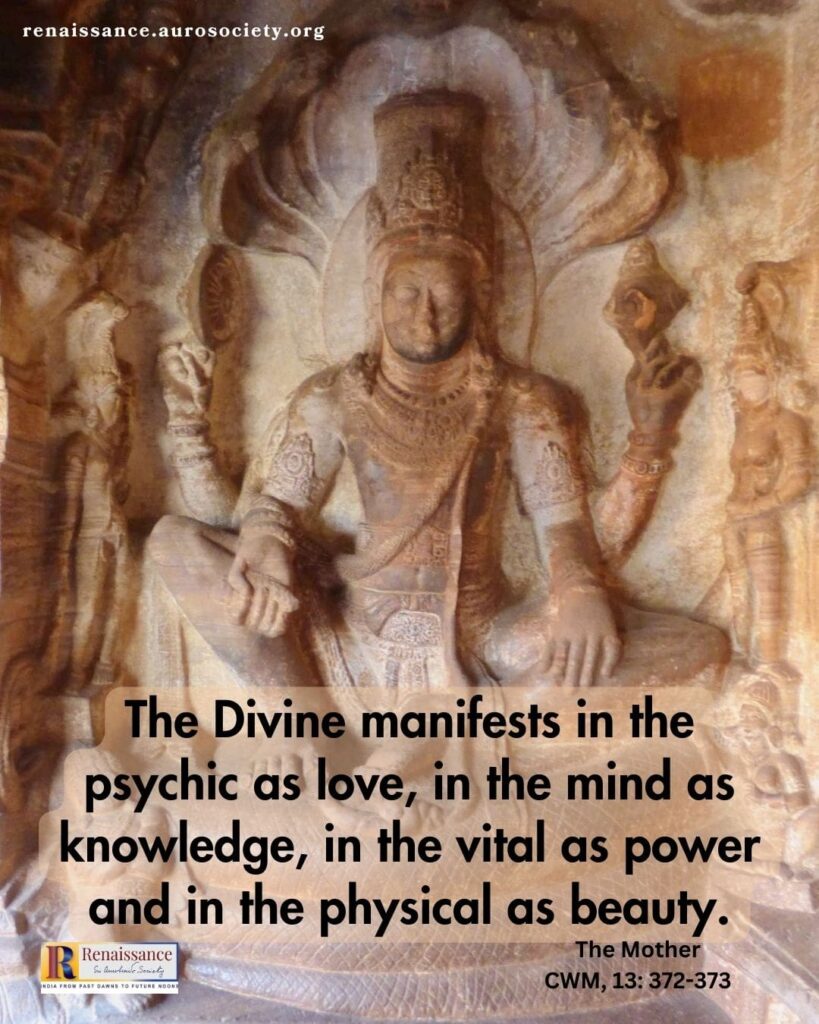
New Renaissance Series on Art
Taking inspiration from these words, we are dedicating several issues of Renaissance to explore the topic – The Spirit and Forms of Art in India. The series will explore Indian Art and Aesthetic traditions in the light of Sri Aurobindo’s and the Mother’s vision. As always, we will feature selected gems from the vast ocean that is their written works and conversations. We shall also highlight some writings of other senior sādhaka-s and scholars. And there will also be a few fresh perspectives and voices.
The subject is certainly a vast one.
We don’t claim that we shall be able to consider the subject thoroughly and fully. But through this series which will go on until July 2025, we hope to highlight a few salient aspects to help the reader gain a broad orientation to appreciating Art, in general, and Indian Arts, in particular. Our purpose is not to highlight the technical details of various art forms. Rather, the focus will be to highlight the deeper spirit of India as reflected in her diverse art forms and her approach to creating and appreciating art.
The First Issue in the Series
The first issue in our series explores the theme – The Purpose of Art: From Beauty to Bliss.
We have all heard of the slogan – Art for Art’s Sake. The phrase represents the philosophy that true art is completely independent of any and all social or moral values. And that art need not serve any utilitarian purpose whether didactic or political. In a remarkable letter Sri Aurobindo wrote a superbly crafted response to this slogan which had gained tremendous popularity in the latter half of the 19th century. He included relevant examples and detailed explanations.
The Aesthetic Movement in the West further popularised this idea. It claimed that art was valuable in itself, and that artistic pursuits were their own justification. The noted author Oscar Wilde also promoted the idea. He went to the extent of saying “All art is quite useless”. And that “to reveal art and conceal the artist is art’s aim” (from Preface to The Picture of Dorian Gray).
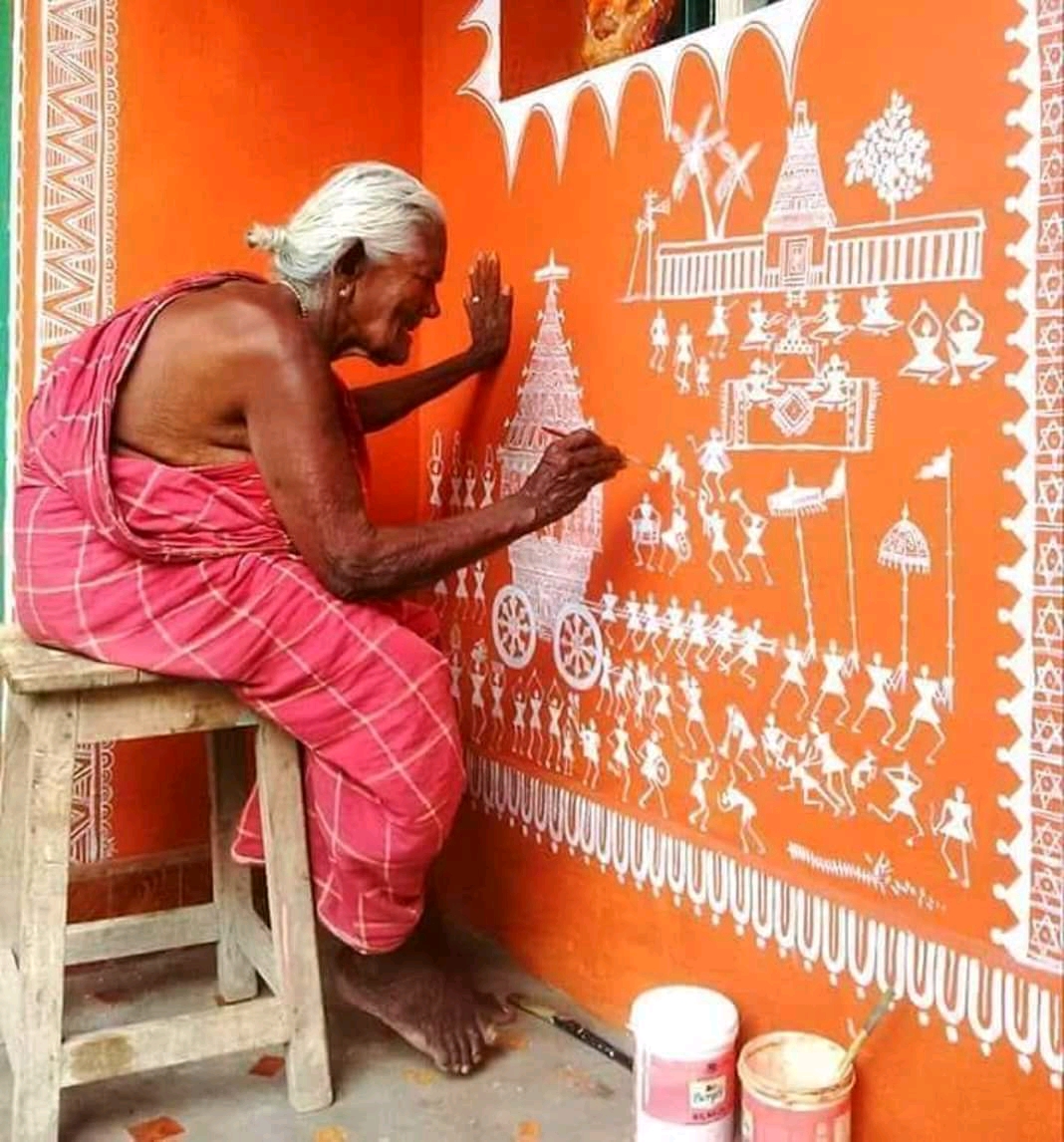
Various socialist and communist thinkers offered a critique of this idea. They claimed that arts must serve the socialist or political agenda. Nietzsche argued that there is such thing as ‘art for art’s sake’; rather art always expresses human values. But Sri Aurobindo’s critique of the idea is based on a deeper vision. His is a spiritual vision of art and its value for the individual and collective consciousness. Read all about it in our feature titled Art for Art’s Sake? Certainly, But Also Art for the Soul’s Sake.
What are we truly seeking when we seek beauty?
How can one consciously appreciate that which is beautiful and true? Is there something like absolute or universal beauty? Read our feature titled “To find highest beauty is to find God” where Sri Aurobindo uncovers the essential truth behind the relation between Beauty, Truth, Goodness, and Delight.
“In India God is the All-beautiful” — this feature highlights a few relevant selections from Evening Talks with Sri Aurobindo. Here we get a deeper understanding of the connection of beauty with the vital and the psychic. And we also learn about the relation between aesthetic refinement and spiritual development.
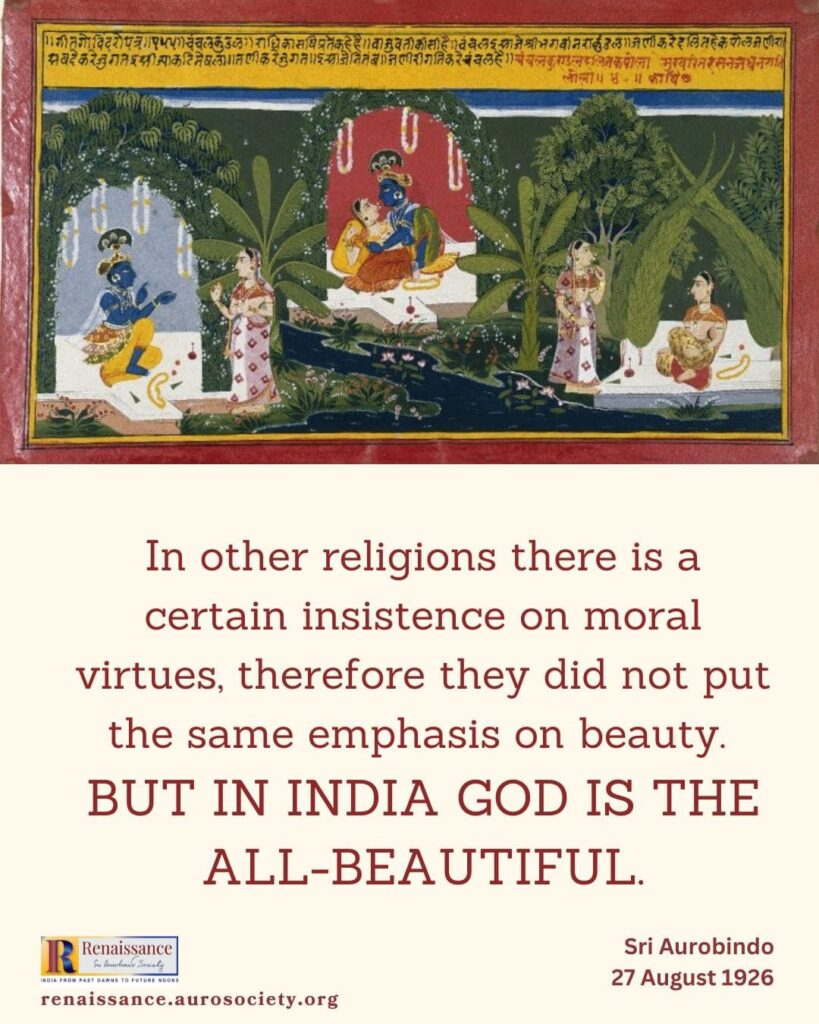
Nature, Beauty and Harmony
Sri Aurobindo wrote a play titled The Harmony of Virtue sometime in 1892. This was his second and last year at Cambridge. Referring to this writing, he said later in life that at the age of 18 or 19, he had started writing under the impression of Plato’s philosophy. And there he was trying to explain the cosmos on the foundation of the principle of Beauty and Harmony. He added that he never got beyond the first three or four chapters. That is what we find today in Volume 1 of his Complete Works.
We are featuring a few passages from this play in Beauty and Harmony in the Warp and Woof of Nature. Here Sri Aurobindo speaks of the Beauty in Nature which is based on the principle of Harmony. We also get some interesting insights into what is beauty, and whether there is an absolute standard of beauty.
We also feature selections from Rabindranath Tagore’s essay titled The Realisation of Beauty. This appears in his book titled Sādhanā: The Realisation of Life, which weaves together many of the ideas culled from his Bengali discourses. In the same feature, we highlight the English translation of one of Tagore’s poems titled Purnima, which speaks of the poet’s deep realisation of beauty on a full-moon night. The translation is done by Narendra Murty.
In the feature titled “Beauty is his footprint….” read about the connection of beauty with delight, harmony and life, and how to experience the delight of beauty. Also, watch a small video featuring an important passage from the Mother where she highlights how “the anguish of desire” distorts the experience of beauty.
In The National Value of Art, Sri Aurobindo speaks of the role that arts and aesthetic development play in the process of cittasuddhi. This is the purification of the citta or mass of established ideas, feelings and actional habits in an individual either by samyama, rejection, or by bhoga, satisfaction, or by both. This purification of feeling, passions and emotions in the heart provides one important justification of why arts and arts education are so essential.
In this regard, read the contemplative composition titled Inner Bliss – Indescribable Beauty by Sudha Prabhu. It speaks of this process of cittasuddhi, the emotional purification, a journey of seeking harmony, beauty and joy. The flower mandalas included in the feature are also her creations. Working with flowers is one of the contemplative aesthetic practices she uses in her journey of self-discovery – from beauty to bliss.
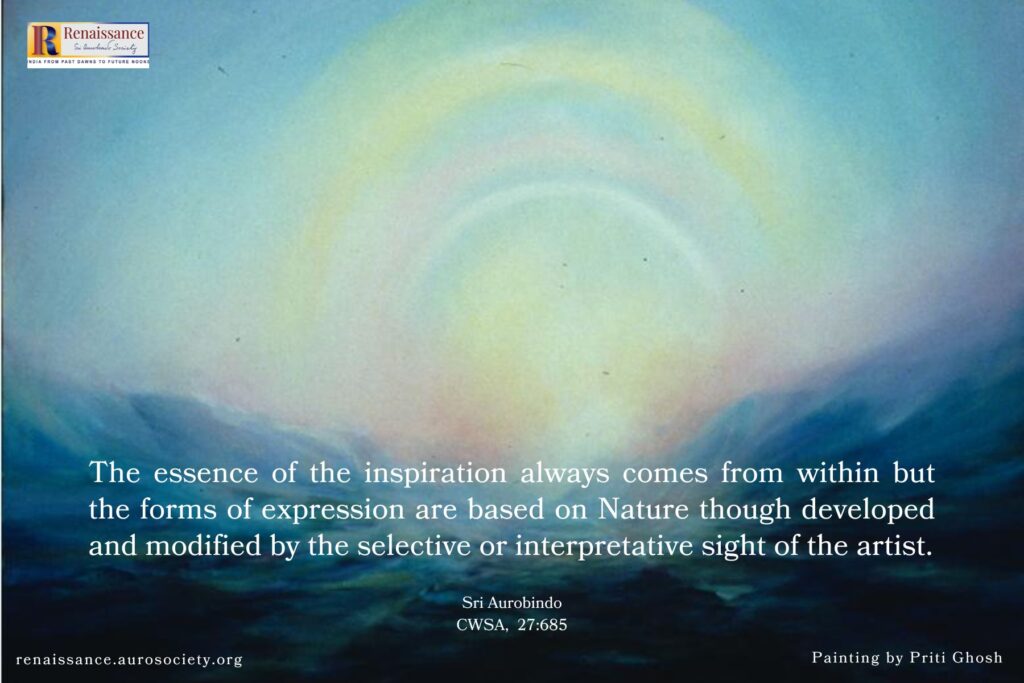
Satyam Shivam Sundaram
We all agree that there is no one standard of beauty. It is equally true that there is a state of consciousness in which everything has its beauty. To an artist’s vision, something that is outwardly quite plain, even ugly, sordid or repellent can become an opportunity to bring out its innate beauty. He may do it through the word, line or colour, or through the sculptured shape. But does this mean that there is a place for ugliness in art?
At a certain elementary stage of one’s aesthetic development, the mind somehow interconnects the ideas of what is beautiful and the what is good or decent. That which is conventionally or customarily or socially acceptable gets identified with beautiful. And the rest is deemed to be indecent, obscene and hence to be cut off from the artistic and aesthetic experience. In its excessive form, this may lead to puritanism and even anti-aesthetic cultural tendencies.
In this regard, let us recall Sri Aurobindo’s words that the progress of ethics in Europe or West has been largely a “struggle between the Greek sense of aesthetic beauty and the Christian sense of a higher good.” The former led to an extreme formalism, and the latter to an unlovely asceticism. By associating the good with virtue this tendency largely drove away the sense of beauty to the side of vice.
In India, on the other hand, the ideal of satyam shivam sundaram has guided the development of aesthetics and artistic creativity. It is understood that the good must not be subordinated to the aesthetic sense. Rather it must be beautiful and delightful, or to that extent it ceases to be good.
Nolini Kanta Gupta explores these issues in an essay titled The Obscene and the Ugly.
He gives several examples to help us understand the argument that while obscenity may have a place in art, ugliness does not. He also gives us a wider lens to understand what constitutes obscenity and what is ugliness. In the later part of his essay we also find a helpful explanation for something Sri Aurobindo once told a disciple. For the perfect creation of beauty, Sri Aurobindo said that three elements are needed. These are: the fundamental element of beauty which is present in everything, the pervading quality or guna, and the expression or form.
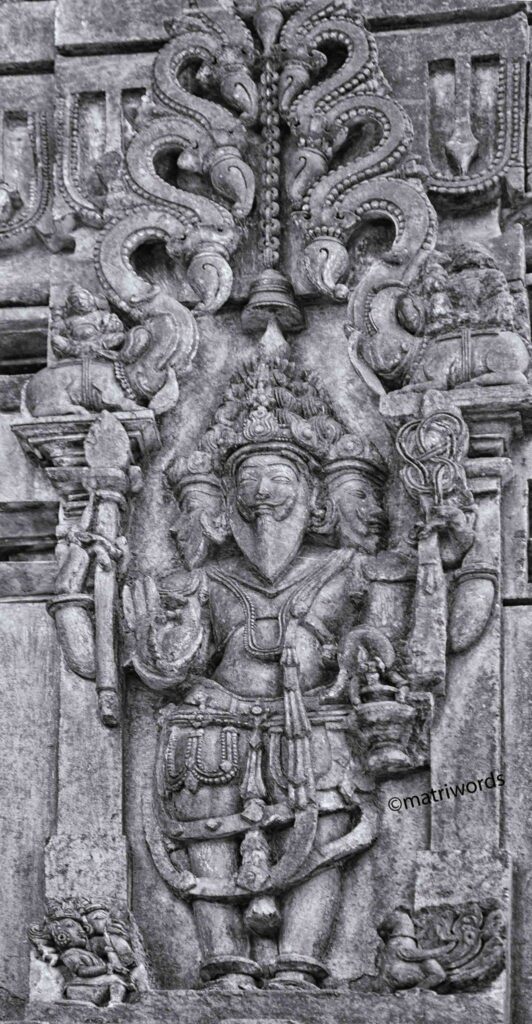
More in this issue
Sri Aurobindo once said that all art is interpretation and creation is a misnomer. It that is the case, from where does the inspiration for artistic creation come? If we agree that an artist receives suggestion from Nature and inspiration from within, is there a place for realism in art? Narendra Murty explores these and a few more questions in his essay titled The Figures of Eternity.
Sri Aurobindo has spoken of the immense value of the efforts of E. B. Havell and the work of the new school of Indian art he helped establish in Bengal in bringing about an important change in the aesthetic standpoint of Western critics of Indian art. The Uses of Art – A 1905 Lecture highlights some excerpts from a lecture delivered by Havell at Chaitanya Library, Calcutta (now Kolkata), in December 1905.
Despite the references to the context of his time, the key points made by Havell are still highly relevant. If anything, the challenges which he points out — mindless imitation of the Western styles, commercialism and lack of higher motive in creating Art — have become even bigger since the time this lecture was delivered.
Padma Shri awardee V. K. Gokak was a prominent Kannada writer and a scholar of English and Kannada literature. In a comprehensive essay, published in two parts in Sri Aurobindo Circle (1949 and 1950), he presented a fresh statement of the meaning of rasa. Rasa, as most readers are aware, is a word almost synonymous with Indian theory of aesthetics. We have made a few selections from that long essay titled Rasa: Its Meaning and Scope which shall serialise in three issues. The first part is included in the current issue.

Exploration continues…
There is a lot remaining to be explored with regard to the purpose of art. Hopefully we will be able to take up some of that in the upcoming issues. We conclude this editorial with these words of Sri Aurobindo, where he reminds us of the highest and the noblest uses of art, namely, its service to the growth of spirituality in the race.
“Spirituality is a single word expressive of three lines of human aspiration towards divine knowledge, divine love and joy, divine strength, and that will be the highest and most perfect Art which, while satisfying the physical requirements of the aesthetic sense, the laws of formal beauty, the emotional demand of humanity, the portrayal of life and outward reality, as the best European Art satisfies these requirements, reaches beyond them and expresses inner spiritual truth, the deeper not obvious reality of things, the joy of God in the world and its beauty and desirableness and the manifestation of divine force and energy in phenomenal creation.”
~ CWSA, Vol. 1, p. 450
He adds that it was only the Indian art, which at its highest, attempted to reach and express the deeper reality of things, and help uplift the consciousness to divine beauty, divine joy and divine love. We shall explore more of this and also the sacred origins of Indian art in the future issues.
We hope our readers will enjoy going through the various offerings in this issue. As always, we offer this work at the lotus feet of Sri Aurobindo and the Mother.
In gratitude,
Beloo Mehra (for Renaissance Editorial Team)

